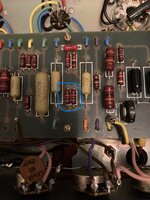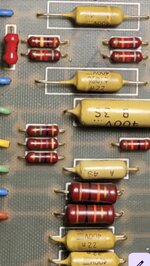Dave L
Well-known member
Hi guys, I´m looking through a ´75 Super Lead I got a while back, I´m not really tech savvy but just reading off some color codes and matching it to schematics. Trying to learn something, I suppose.
It seems more or less stock and/or what you might expect to find, but what are these two supposed to be? I can´t really match them up to any typical values, and it does look like there´s been maybe a PPIMV mod here judging from the soldering and the extra hole in the front panel. Are these the 220K coming off the PI I see on the schems switched to 82K, or am I just way out of my depth here?
EDIT - after a bit of extra googling it seems like 82K also is a stock value, but mostly used for the 6550 versions. This does have EL34s now, but these 82K ones probably stayed on in the conversion. Any thoughts on the benefits of going to 220?
It seems more or less stock and/or what you might expect to find, but what are these two supposed to be? I can´t really match them up to any typical values, and it does look like there´s been maybe a PPIMV mod here judging from the soldering and the extra hole in the front panel. Are these the 220K coming off the PI I see on the schems switched to 82K, or am I just way out of my depth here?
EDIT - after a bit of extra googling it seems like 82K also is a stock value, but mostly used for the 6550 versions. This does have EL34s now, but these 82K ones probably stayed on in the conversion. Any thoughts on the benefits of going to 220?
Attachments
Last edited:


